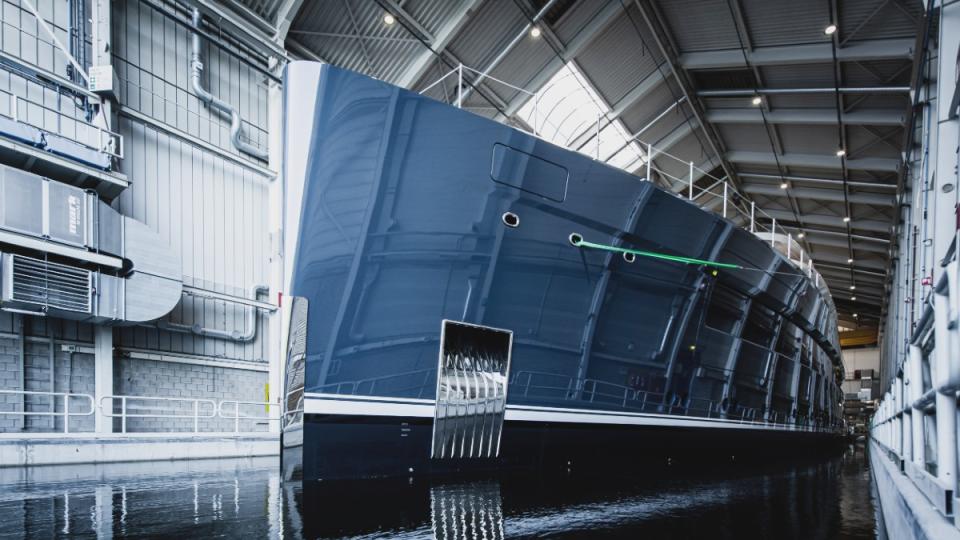Feadship’s New 195-Foot Hybrid Superyacht Is 35% More Efficient Than a Conventional Vessel

Feadship’s Project 713 is the third launch in three months that has been built around sustainable technology. With its blue-gray steel and white superstructure, the svelte 195-footer is the first Feadship to carry solar cells for auxiliary power generation, combined with its diesel-electric main propulsion. The solar panels, which were custom-made in the Netherlands, are expected to produce up to 24 MWh annually. The diesel-electric power system is comprised of four generators, a lithium-ion battery and four Caterpillar engines.
The company said that an independent sustainability assessment called the Yacht Environmental Transparency Index (YETI) found that Project 713 was ranked at “best in fleet,” with a 35 percent below-average impact compared to other yachts in its class.
More from Robb Report
Pup Deck? These Superyachts Were Designed With Their Owners' Dogs in Mind
The World's First Hydrogen-Powered Superyacht Just Hit the Water
This New 248-Foot Superyacht Has Its Own Sports Court on the Deck
The Dutch shipyard has long promoted itself as a champion of sustainability, with a goal of developing “net-zero” yachts by 2030. It launched the world’s first hybrid superyacht, the 274-foot Savannah, which used a single main engine with three gensets, batteries, and a more efficient hull shape. At the time, Feadship said it used a third less fuel than other yachts its size.

Since then, the technology has evolved to the point where many shipyards are producing hybrid-electric yachts. Feadship’s Project 1012, launched in April, is the yard’s first full hybrid-electric class yacht. The 301-footer, built for a repeat Spanish client, has a navy-blue hull and white aluminum superstructure. It also has a beach club that occupies about one quarter of its length. The owner wanted 33-foot tenders, a ski boat and multiple water toys.
But the defining characteristic is the hybrid propulsion system. The boat has two main MTU diesel engines joined to two 560kW PTO/PTI electric motors and 1MW of Li-ion batteries. The e-motors work as shaft generators to produce electricity for the hotel loads, recharge the battery banks, and for low-speed navigation.
These two superyachts, and a third last year called Obsidian, are evolutions of existing technology. But the true breakthrough was Project 821, which left Feadship’s Amsterdam shipyard on May 4. At just under 390 feet, It is the largest and technically the most complicated yacht Feadship has ever built, and a first for the superyacht industry. The vessel does not have primary diesel engine, but rather propels itself via hydrogen and electric engines.

The yacht was extended by 14 feet to accommodate the liquid hydrogen tanks. The process was more than a technical exercise since there are no regulations for hydrogen storage and fuel cells in the superyacht sector. The shipyard worked with the PowerCell Group, a firm providing fuel-cell technology for passenger and car ferries, as well as with Edmiston Yachts and Lloyd’s Register to develop a system with scaled equipment, protocols and safety regulations. The yard had to develop a double-walled cryogenic tank to store the liquid hydrogen at -424 degrees F that power 16 fuel cells that convert hydrogen to electricity. The company said the fuel-cell technology can provide a week’s worth of silent operation cruising at 10 knots.
The yacht’s profile by RWD design includes 14 balconies that slide out from the yacht’s side, as well as seven large opening platforms to form a connection with the sea.
“The aim has been to develop a new, clean technology not just for this project, but for the world,” Jan-Bart Verkuyl, Feadship director and CEO of Royal Van Lent’s yard, said at the time of the launch. Fuel cell technology, including methanol-powered fuel cells, will play an important part in yachting, he added, not only with low particle emissions, but also with low noise radiation and efficiency.
Best of Robb Report
Sign up for Robb Report's Newsletter. For the latest news, follow us on Facebook, Twitter, and Instagram.


